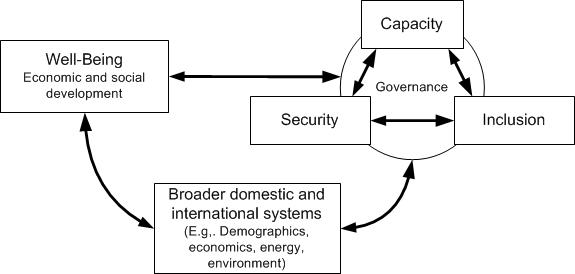International Futures Help System
Governance
Overview
Governance is the two-way interaction between government and the broader socio-political or, even more broadly, socio-cultural system. Although our documentation and the IFs model itself focuses primarily on three dimensions of that governance interaction, we will need also to direct some attention specifically to that broader socio-cultural system and how it might change over time.
The conceptual foundation for the representation of governance in IFs owes much to an analysis of the evolution of governance in countries around the world over several centuries. That analysis (see Chapter 1 of the Strengthening Governance Globally volume by Hughes et al. 2014) identified three dimensions of governance: security, capacity, and inclusion. It traced them over time and noted their largely sequential unfolding for currently developed countries and their currently simultaneous progression in many lower-income countries.
The three dimensions interact closely and bi-directionally with each other. They also interact bi-directionally with broader human development systems. The level of well-being, often captured quantitatively by GDP per capita or the more inclusive human development index, may be especially important, but is hardly alone in helping drive forward advance in governance; for instance, the age structures of populations and economic structures also interact with governance patterns both indirectly through well-being and directly.

The conceptualization of governance further divides each of the three primary dimensions into two sub-dimensions partly based on the desire to quantify them historically and to facilitate forecasting. For security those are the probability of intrastate conflict and the general level of country performance and risk. The two sub-dimensions of capacity are the ability to raise revenue and the effective use of it and the other tools of government—that is, the competence or quality of governance. We use corruption (that is, control of it) as a proxy for such competence. The first sub-dimension of inclusion is the level of formal democratization, typically assessed in terms of competitive elections. More broadly democratization involves inclusion of population groupings across lines such as ethnicity, religion, sex, and age; we use gender equity as a proxy for the second dimension.
See Hughes et al. (2014), especially Chapter 4, for more background on the development of the governance representations of IFs than this documentation provides. See also Hughes (2002) for earlier and/or complementary work in IFs on socio-political representations (domestic and international); for example, here we do not discuss the formulations for power, interstate threat, and conflict, but that is available in documentation on the International Political model of the IFs system. Finally, we not provide here the important information about the forward linkages of governance to other elements of IFs, including to the production function of the economic model and to the broader financial flows of the social accounting matrix representation. See documentation on the economic model for that information.
To read more about the governance module, please click on the links below.
- Structure and Agent System
- Dominant Relations
- Flow Charts
- Equations
- Performance Risk Analysis Form
- The Broader Socio-Cultural Context
 International Futures at the Pardee Center
International Futures at the Pardee Center